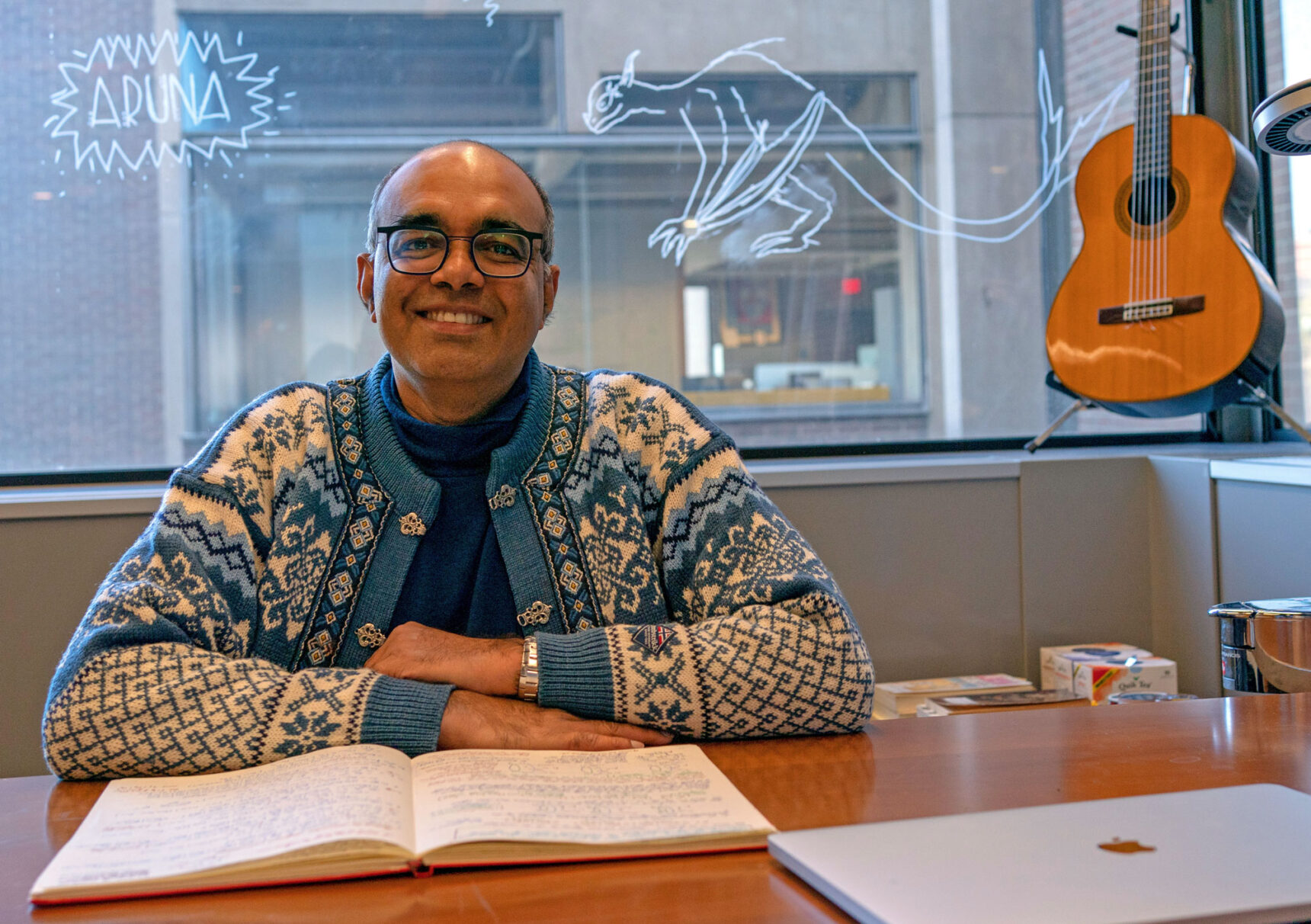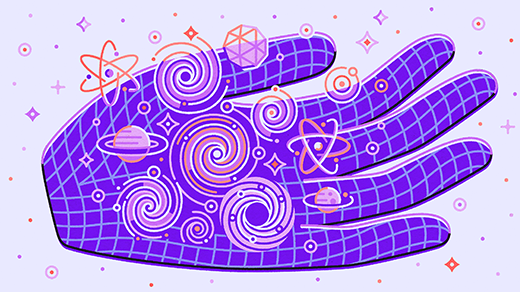Pondering the Bits That Build Space-Time and Brains
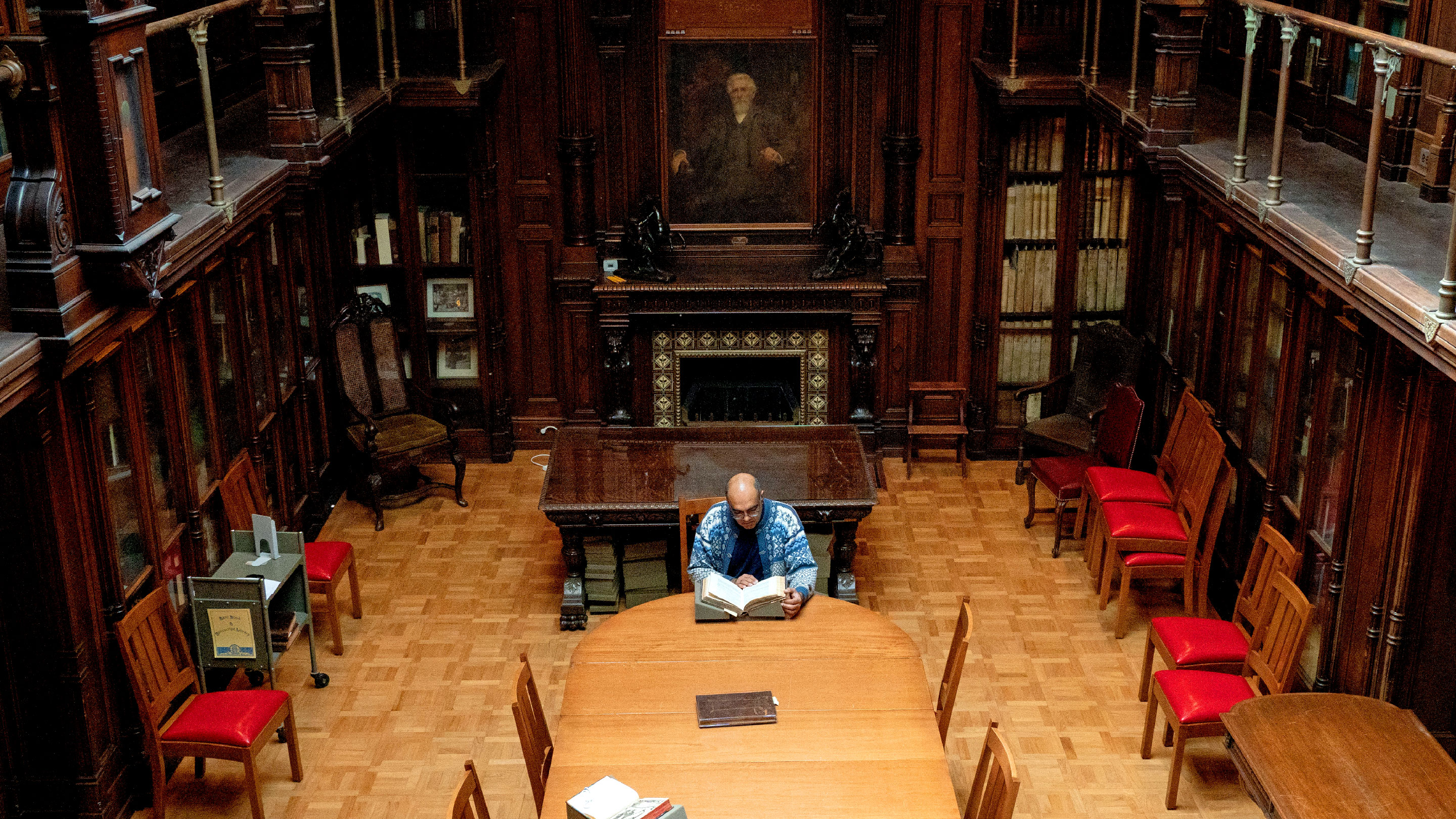
Vijay Balasubramanian, pictured browsing a first edition of Newton’s Principia Mathematica at the University of Pennsylvania, has argued that a black hole is like a library that contains all possible sequences of letters.
Caroline Gutman for Quanta Magazine
Introduction
In 1989, the renowned physicist John Wheeler, popularizer of the term “black hole,” proposed a radical new way to think about the universe. Quantum particles may shape-shift and disappear, but we can always count on information: the answers revealed when we ask questions through measurements. Wheeler speculated that bits of information — whether something is present or absent, up or down, 0 or 1 — could be the fundamental ingredients of reality. “Every physical quantity, every it, derives its ultimate significance from bits, binary yes-or-no indications,” he wrote in an essay envisioning an “it from bit” cosmos.
In the decades since, various abstract developments have led many physicists to wonder whether Wheeler’s thesis could unlock a profound puzzle: the quantum nature of gravity. Albert Einstein’s general theory of relativity unified gravity with the fabric of space-time, reinterpreting the gravitational force as objects falling along the curved contours of the cosmos. Yet quantum theory struggles to explain these curves in its language of particles and fields. The conflict is on full display in black holes, which deform space so severely that gravity’s more fundamental, quantum nature cannot be ignored.
Hints that a black hole’s surface area matters more than its volume led to an astonishing discovery in 1998: A toy universe that curves like a saddle, called anti-de Sitter (AdS) space, is mathematically equivalent to its lower-dimensional boundary. In this imaginary world, the direction pointing into the interior seems illusory, like the depth of a hologram.
As theorists study black holes and other objects in AdS space, they keep learning Wheeler-esque lessons. One is that the connectivity of space — the ability to get from one place to another — seems to stem from particles on the boundary linked by correlations known as quantum entanglement. If one particle is pointing up, for instance, this tells you its entangled partner points down. This kind of information-sharing on the boundary of AdS space appears to enable the voluminous structure of the interior.
Vijay Balasubramanian of the University of Pennsylvania is one of the physicists working to translate Wheeler’s lofty ideas into crisp mathematics. The research he and his colleagues engage in now goes by the slogan “it from qubit,” since quantum bits, or qubits — complex combinations of 0s and 1s — are more general than classical bits. In 1999, Balasubramanian worked out how to calculate mass and energy in AdS universes in terms of information about particles on the boundary. Since then, he has made fundamental contributions to theories of black holes and quantum gravity by studying the information content of various systems.
A playful polymath who is prone to leaping from physics to Proust in mid-conversation, Balasubramanian directs an entire second research group at Penn that details how the world’s physical features have sculpted the brain. In neuroscience, too, he has found that ideas of information and computation provide a natural language.
Quanta Magazine recently connected with Balasubramanian over Zoom for a conversation about the role of information in physics and neuroscience, and about the limits of human cognition. The interview has been condensed and edited for clarity.
You’ve spent your career working on some of physics’ most intractable problems. Is progress actually being made?
The developments in the last 20 years have been enormous. One important advance has been the understanding that a universe that curves like a saddle — AdS space — where gravity operates in the familiar but poorly understood way, can be seen as equivalent to a lower-dimensional world that’s free from pesky gravity. This is the famous AdS/CFT duality. This concept opens the possibility that space is not fundamental. Rather, it could be emergent. A lot of my work has been concerned with that: developing a theory that doesn’t contain space.
Very recently there’s been wonderful progress in thinking about whether you can see behind the horizon of a black hole by measuring particles that radiate out, which may contain scrambled messages about what previously fell in.
How do black holes and AdS/CFT lead you to the notion that information could be the basis for space?
Quantum mechanics has a property called unitarity which guarantees that at a microscopic level, information cannot be destroyed. But Stephen Hawking calculated that information is destroyed as a black hole evaporates — creating a paradox. You have a tension between gravity and quantum mechanics arising from the destruction of information.
We also know that the entropy of a black hole, which is a measure of ignorance or lack of information, equals the black hole’s surface area. There’s clearly something going on linking area, entropy and information. You can feel it, but you don’t know what it is, so people have been feeling around for what to say about it.
One thing we look at is how the structure of space in the volume of an AdS universe manifests on the boundary. For example, what does it mean for you to be able to move an object from point A to point B inside the universe when space isn’t fundamental? There is now an argument that if two regions in the volume of space are connected, then in the “flat world” boundary, the corresponding variables are entangled quantumly. That means they contain information about each other; measuring one tells you something about the other. It’s a very beautiful idea, and a specific realization of Wheeler’s it-from-bit notion: If these bits of quantum information were not connected through entanglement, then there’d be no space.
Are you saying that our 3D universe might really be an optical illusion generated by entangled 1s and 0s in some flat land?
It’s completely fair to think about that literally. But debate continues on how far you can take this idea.
What’s a less literal interpretation?
It’s hard to say at this stage. Part of the difficulty is that you need some vocabulary for what you mean for space to emerge. From our perspective, space looks nice and smooth, right? We might say that A and B are connected in space if we can draw a smooth line between them. But now suppose I take a microscope and look at a tiny region. Up close, you have every reason to expect that space itself, like everything in quantum mechanics, is fluctuating like crazy, bouncing around and ripping apart. In that case, what does it even mean to say A is next to B?
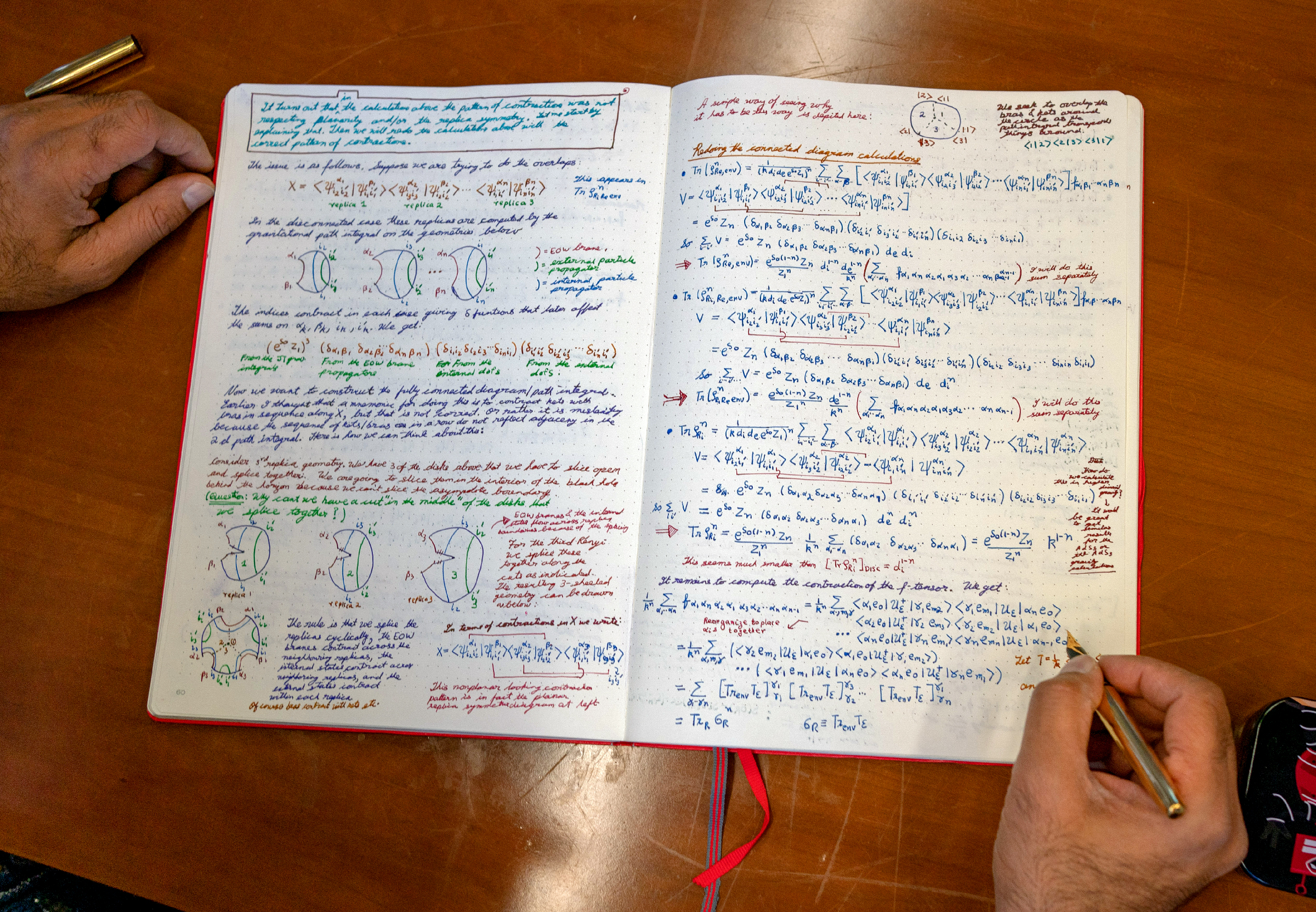
A page of Balasubramanian’s notebook discusses quantum error correction, black holes and gravity.
Caroline Gutman for Quanta Magazine
We must be willing to open our minds to more subtle ideas of space, which is hard because our imaginations are closely tied to our daily experience as large animals. But if someone had told me 20 years ago that I could even talk about this at all, I’d have said there was no chance. Perhaps in another 20 years we’ll have an answer to your question.
We can’t yet probe quantum gravity in experiments. How can you tell when your outlandish ideas are working when you’re unconstrained by experiments?
That’s the thing; the mathematical consistency of the laws of nature is a drastic constraint. I don’t think people appreciate just how many things you cannot do if you agree with a set of rules.
Sometimes progress in theoretical physics comes when you remove an assumption. If you derive a bunch of theories consistent with rules, and the theories don’t describe the phenomena you think they should, it’s perfectly fair for you to question the rules.
For example, last year some colleagues and I studied what would happen if you entangled two gravitating universes. Suppose the two universes are not connected; they’re disjoint. Einstein’s picture of space requires that disjoint universes be completely severed, with zero paths from A to B. But we modified that assumption. We said, let’s allow the wild fluctuations of quantum gravity to establish fleeting connections. That could make sense!
We found that this tweak makes a computation work. An apparent information paradox can be avoided if you agree that the rules for computation in quantum gravity let disconnected universes become momentarily linked.
What else can you do with an information-first approach in physics?
I once wrote a paper called “The Library of Babel: On the Origin of Gravitational Thermodynamics.” The name was inspired by a short story of Jorge Luis Borges about a mysterious library filled with books that look like nonsense. Eventually a librarian realizes that this library contains all possible sequences of letters. Almost all sequences are basically random, but every once in a while, you have the true story of someone’s life.
We argued that the collection of ways in which black holes can arrange the information they contain is like this library. Like the books, the black hole’s “microstates” consist of nearly random combinations of its microscopic pieces. Information is preserved, but it’s next to impossible to recover.
Another time we investigated bubbles of nothing. In certain universes with too many dimensions, when you squish down the extra dimensions these universes can develop an instability where they make a bubble with no space inside.
I was very interested in this nothing. In the language of AdS/CFT, a bubble of nothing in the emergent volume of space occurs when the fundamental degrees of freedom in the flat world are no longer entangled. But those [qubits] are still there in the flat world; it’s not nothing. It’s a thing. The thing is not entangled in the right way to make a space, but there’s still information in the nothing state.

Balasubramanian stands in front of the Spectral Grove sculpture in Penn’s Pivot Park.
Caroline Gutman for Quanta Magazine
What was your first encounter with scientific reasoning?
When I was in second grade we lived in Calcutta, India, and would go shopping for vegetables on the weekend. We would pass these booksellers with stalls built into the walls of buildings. I treasured the books I was able to get my hands on. My dad made a little bookshelf out of packing crates from local shops, and I would line up my handful of books and count them. My ambition in life was to someday own 100 books.
One day I picked up a book called The How and Why Wonder Book of Famous Scientists. In particular I remember Antonie van Leeuwenhoek. He didn’t have a degree. He didn’t work in a fancy place. He was a lens grinder. But he was an intelligent and curious guy, and so he used his lenses to assemble the first microscope and discovered the entire world of microscopic life. I remember reading this and realizing that science was a thing you could do. It wasn’t received wisdom from ages past. From then on, I knew what I was going to do in life.
You studied both physics and computer science at the Massachusetts Institute of Technology. Why the latter?
I had begun to feel that the laws of nature as we write them down are fundamentally constrained by the thoughts we can think. A cat can’t understand calculus, and it’s not obvious that humans can understand everything either. I studied computer science because I wanted to understand the limits of the computer in my head.
How did your alternative life as a neuroscientist get started?
As a postdoctoral student at Harvard, I did my main research in string theory, but I also moonlighted in biology labs. I’d spend evenings at my friend’s lab looking at his data and reading papers. I’d wormed my way out of all my high school biology courses, so I had a lot to learn.
Then I came to Penn and met Peter Sterling, a neuroscientist. He would ask me questions like, “Why does this circuit look like this?” or “Why does this neuron look like that?” These are excellent questions because form follows function in biology.
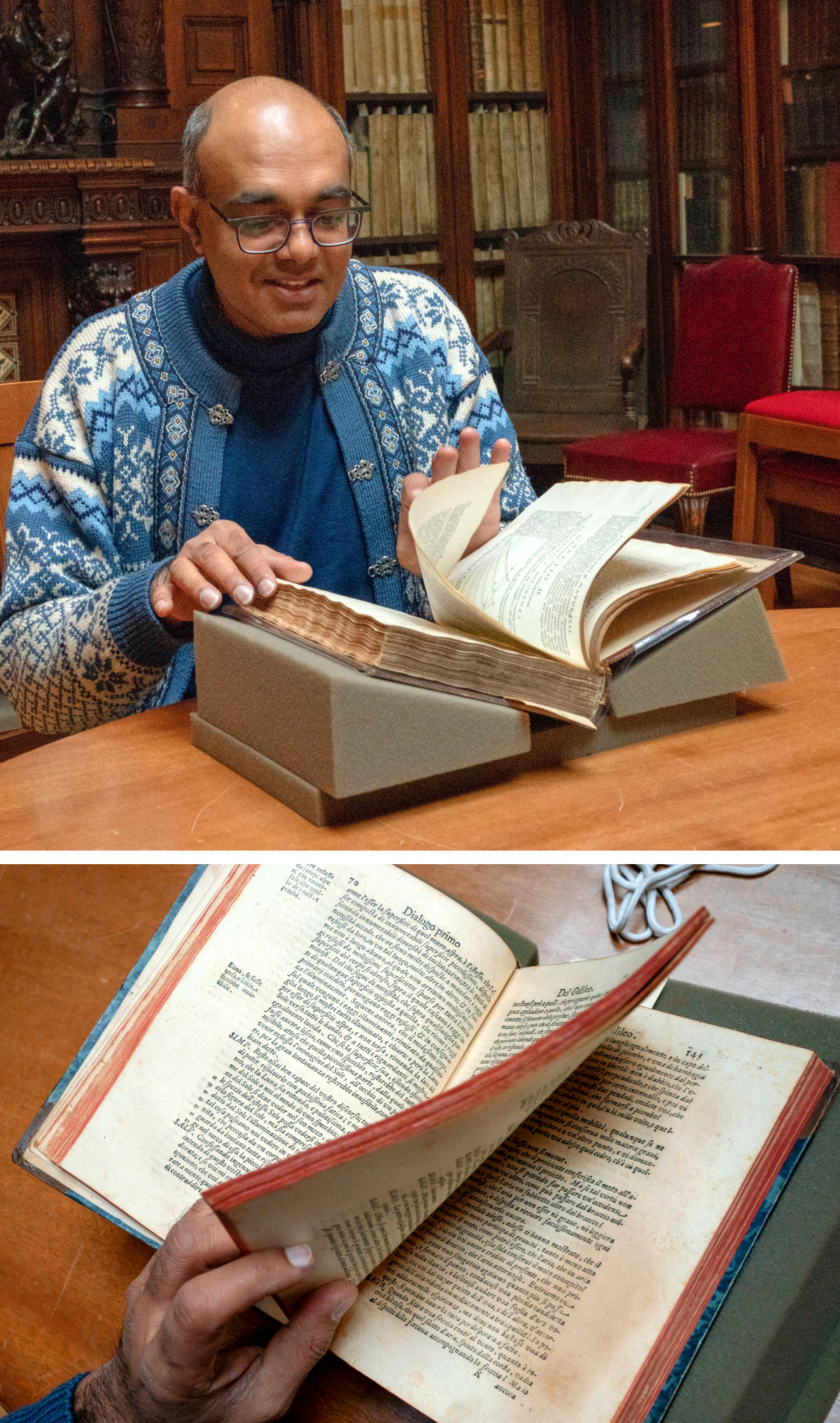
Balasubramanian flips through first editions of Newton’s Principia Mathematica (top) and Galileo’s Dialogue Concerning the Two Chief World Systems (bottom).
Caroline Gutman for Quanta Magazine
What are some of the forces you’ve identified that have sculpted the form of the brain?
Neural information is very expensive. It costs a lot of power, so if you think about the theory of energy-efficient ways of encoding information, maybe that should tell you about the brain’s structure.
For example, there are different pathways in the brain for processing light patches and dark patches, and the brain devotes more resources to dark spots. Why would it do that? We showed that if you look at the statistical structure of natural images, there are more dark spots than light spots. We developed a quantitative theory predicting how many light detectors and dark detectors you should have to maximize your visual information if you were to set up an artificial system on a fixed budget. And you pretty much end up spot on with what you see in animals.
Have you answered your question about the constraints of the computer in your head?
My neuroscience research has given me insights into why the computer is organized the way it is, but I don’t think I’ve learned much about the limitations of the processes in my mind that let me do physics. I still have hope of getting there. I think those higher-level processes are repurposing more elementary things we need to do to survive. It’s far more important to eat than it is to do physics.
So do you feel like the cat trying to learn calculus? Is the entropy of disjoint universes pushing our cognitive limits?
You would think that, but we keep finding more! There’s a genuine mystery about this. We’re just using simple mathematical theories, but we’re talking about whether space-time is put together in an emergent way by entanglement. It’s so removed from our daily experience that it’s preposterous we’re able to extrapolate so far.
There’s a problem here to be understood. The power of simple theories is a gift we don’t deserve, basically.
How’s your book collection doing? Have you built your Library of Babel?
After my wife and I had our second child, we wanted to move to the Philadelphia suburbs. One afternoon we drove out here and saw four houses, and the moment I walked into this house and saw this room full of shelves, I knew it would be our home.
Now it’s full of hundreds of books. My wife’s a historian here at Penn, so she accumulates books too. And I still have all my storybooks from when I was a kid — dog-eared, with thumbprints and food marks and all.
Editor’s note: Balasubramanian has received funding from the Simons Foundation, which also funds this editorially independent magazine.
